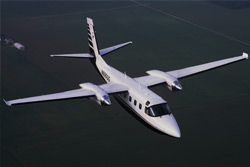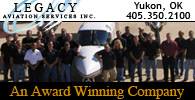HOW TO SERVICE THE HYDRAULIC
ACCUMULATOR-REGULATOR


by J. Scott Dickey
Twin Commanders depend on hydraulic pumps and fluid to power a number of critical systems including flaps, landing gear, nosewheel steering, and brakes. Thus, a problem with the hydraulics is a problem indeed. One such problem that can be handled relatively quickly and easily is a low nitrogen charge in the hydraulic accumulator-regulator.
The accumulator-regulator, located in the left engine nacelle just forward of the hydraulic reservoir, serves to dampen pressure surges in the hydraulic system, and unload the hydraulic pumps when hydraulic systems are not operating. A cushion of nitrogen gas balances a floating piston against hydraulic pressure. Rapidly fluctuating hydraulic pressure may be a sign that nitrogen pressure is abnormally low, and needs replenishing.
The good news is that most Commander owners and operators have the resources at their local airport to service the nitrogen charge rather than firing the airplane up and flying to a service center.
Here�s a simple step-by-step procedure to service the nitrogen charge in the hydraulic accumulator-regulator:
- Connect a 600-psi nitrogen source to the accumulator fitting and make sure the fitting is open by turning the locknut counterclockwise at least two turns. Leave the nitrogen source ON and the regulator set for 600 psi +25/-0 psi.
- With all power OFF (engine-driven and aux pumps), move the flap handle from the neutral position up or down very slowly until you hear the pressure bleed down to zero. (You can see this happen on the gauge and you can hear it through the flap valve.) It turns out the flap valve has a bleed port that bleeds pressure just before going to the flaps UP or flaps DOWN position. If you move the handle slowly, you will hear pressure relieve and see the gauge go to zero a quarter-inch or so before getting to the flaps UP or DOWN position. Now the piston in the accumulator is at the end of its stroke with 600 psi nitrogen on one side and 0 psi hydraulic fluid on the other.
Check your accumulator for internal leaks. Now that you have 600 psi on the accumulator, you can see and hear if the piston O-ring is leaking. If you hear anything, open the hydraulic fluid reservoir to check for foam or bubbles. If there is nothing, proceed to step 4. If you see bubbles and the thing is hissing away, take a deep breath and cancel any upcoming trips. The good news is that Higher Planes (http://www.higherplanes.com/) has an FAA-approved overhaul for that component (along with other Commander stuff like power brake valves).
- With the nitrogen still ON, tighten the lock nut on the fitting and remove the nitrogen fill hose. Don't forget to turn off the nitrogen before removing the fitting�600 psi is a lot of pressure.
I believe this is the first time I've flown the airplane with the accumulator serviced properly. The hydraulic pressure gauge now barely moves, even when actuating the flaps, brakes, etc. It used to snap back and forth during flight, and especially when using the system. When serviced properly, the accumulator does an excellent job of dampening the pressure in the system, to the point where there is almost no pressure fluctuation at all. If your gauge moves much at all or if you see any rapid movements, chances are you have flat or low accumulator pressure. The other trick to doing this properly is finding a nitrogen source that can go up to 600 psi. Almost everyone has an N2 bottle with the welder-style regulator, but most of those cannot regulate to 600 psi downstream pressure.
I decided to look for the components to buy, and I had to search hard for a regulator that could regulate to 600 psi. Most regulators that I saw have maximum of 350 - 450 psi regulating ranges. They maybe go a little higher, but you're lucky if your mechanic has the proper rig. If you are looking to build your own rig, plan on spending about $500. Here are sources for everything you will need:
- 110-cu-ft or larger N2 bottle. You�ll find them at any local welding shop. About $200 buys the bottle, and refills are cheap.
- A 0 - 1500 psi high-pressure regulator. Available from
www.weldingsupply.com. Item # 3200300, about $230.
- High-pressure hose and N2 ground-service fitting, available from Hoses Unlimited (510-483-8520). They will make up a hose of any length and sell you the fill-fitting as well. The regulator terminates in 1/4 NPT female, so you want a hose with 1/4 NPT male on one end.
So that's it. Anyone who is ever in the KLVK area, stop by for a free N2 fill.
J. Scott Dickey�s company, JTech Solutions, Inc., operates a Twin Commander.
Discuss this article in the forums...








